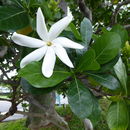pms
nòm ant ël fil


The Tahitian gardenia (Gardenia taitensis), also known as the Tiaré flower, is one of about 140 species in the subtropical and tropical, evergreen, shrubby Gardenia genus (family Rubaceae).Although the first scientific specimens were collected in Tahiti (by Jules Dumont d’Urville, 1824), the species is not native or naturalized in Tahiti, rather it originated in Melanesia and Polynesia and traveled with aboriginals who introduced it to the Cook Islands, French Polynesia, and Hawaii.
This shrub has glossy dark green leaves and grows up to 4-6 meters (12-18 feet) in height. Like many Gardenia species, the Tahitian gardenia produces many white pinwheel flowers each up to 10 cm across with a strong, sweet fragrance. It is cultivated widely (especially the male plants, which produce more flowers) and propagated by cuttings.Across its distribution the flowers are worn behind the ear of men and women and strung into leis. Native Polynesians used infusions of the bark and flower in water or coconut oil (“Monoi,”) as an antiseptic, anti-inflammatory and other medicinal uses, and a scented cosmetic oil to protect skin and condition hair. Research by Bhagya et al. (2011) found support for anti-inflammatory and analgesic activity in mice and suggest it may be due to steroids in plant extracts.Claude-Lafontaine et al. (1992) chemically analyzed the volatile constituents of the flower, finding numerous dihydroconiferyl esters unique to the species.
(Bhagya et al. 2011; Claude-Lafontainea et al. 1992; Lorence, date unspecified; National Tropical Botanical Garden 2014; Wikipedia 2014)